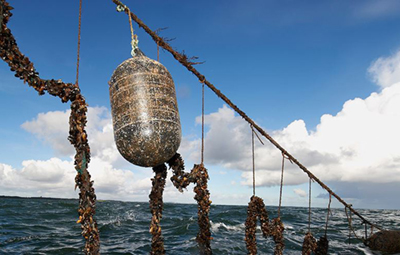
Lindsey Welling
The Log Newspaper.
The Ventura Port District hopes getting into the aquaculture sector will help them further diversify their commercial fishing industry.
VENTURA—Imagine this: miles off the coast of Ventura, under the surface, hundreds of dangling ropes teeming with mussels. That is the vision of the Ventura Shellfish Enterprise (VSE). Efforts to bring aquaculture to the Ventura Harbor area have been afoot since 2015 and the plan has been modified over the years, but it is pushing forward with the same goals: to provide safe, sustainably produced, and locally grown shellfish while also boosting the local economy.
“We want to have a strong, diverse commercial fishing industry that includes aquaculture,” Brian Pendleton, general manager of the Ventura Port District, said.
VSE is comprised of partners from the Ventura Port District, Coastal Marine Biolabs, Cultured Abalone and Ashworth Leininger Group. The plan is to build a shellfish farm in federal waters about 3.5 miles from Ventura Harbor. The project would entail 20, 100-acre plots in federal waters in the Santa Barbara Channel the private sector could sub-permit to grow Mediterranean mussels. The Ventura Port District submitted permit and project applications in October 2018 to the U.S. Army Corps of Engineers and California Coastal Commission.
VSE delivered a presentation on the status of the project to Port Commissioners on July 17. Pendleton said they are still going through the lengthy permitting process. Project implementation is dependent on that process but could be as early as the winter of 2020 or early 2021.
While aquaculture – the farming of fish, shellfish, and aquatic plants – is nowhere new in the U.S., in some ways, the port district is navigating unchartered waters. While not new on a global scale, offshore shellfish farming in federal waters is still in its infancy here in the states. Diane Windham, the aquaculture coordinator for National Oceanic and Atmospheric Administration (NOAA) Fisheries West Coast Region, said there aren’t many aquaculture projects permitted offshore in California or across the U.S. and a lot goes into it, including research and environmental studies. Part of Windham’s job entails giving regulatory guidance and expertise to applicants seeking entry to the aquaculture industry. She said because offshore shellfish farming is relatively new and because of the present regulatory structure, the permitting process is unpredictable.
“It’s a little bit of a moving target,” Windham said.
She said the lengthy and costly permitting process is one of the current challenges in the development of any aquaculture project. Pendleton said the Ventura Port District is hoping to remove that barrier to entry for mom and pop shops by going through the permitting process and allowing the private sector to sub-permit from them. The sub-permits would still need Army Corps approval but it would be an expedited process.
“There’s a great alignment between our goals and creating an opportunity for the private sector,” Pendleton said.
One hope for the project is it would enhance and sustain Ventura Harbor as a major west coast fishing port and support the local economy.
“Commercial fishing is the leading part of this harbor’s economy,” Pendleton said.
Pendleton added the full project build out and operation could generate a maximum of $45 million to $55 million in annual wholesale value, with the more conservative estimates putting the predicted annual wholesale value at $22.5 million to $27.5 million.
Pendleton continued squid currently dominates the Ventura commercial fishing market. According to records held by the California Department of Fish and Wildlife, Port Hueneme, Ventura and Santa Barbara-area landings for squid in 2018 were valued at a combined $13.6 million.
Windham said aquaculture projects create lots of potential for job creation and re-invigorating waterfront communities. NOAA Fisheries aims to foster responsible aquaculture that provides safe, sustainable seafood; creates employment and business opportunities in coastal communities.
“This project has embraced these philosophies,” Windham said.
Researchers involved in the VSE project say shellfish farms have the ability to feed more people with less environmental impact. Mussels feed exclusively by filtering naturally occurring microscopic plankton and organic particles from the water column. Researchers say when compared to beef, chicken, pork, or fish, mussels and other bivalve produce the smallest environmental footprint.
Aquaculture is not new, but it is growing. According to NOAA, marine aquaculture production increased an average of 3.3 percent per year from 2009-2014. Windham said it is a slow growing industry.
“I do get a lot of calls from folks who are interested in developing their own aquaculture farm,” Widnham said. “The past two-to-three years there has been a huge uptick in that.”
Ventura Port District is not the only one to see opportunity in the aquaculture sector in California. Located about 10 miles out from San Pedro and six miles from the coast of Huntington Beach is Catalina Sea Ranch, which bills itself as the first aqua farm in federal waters. The company raises mussels, kelp, oysters, scallops and more. Other mussel farms exist in state waters all across California, including the nearby Santa Barbara Mariculture Farm.
According to NOAA, aquaculture supplies more than 50 percent of all seafood produced for human consumption. Windham said the U.S. currently imports about 85 percent of its seafood. As for the future of aquaculture, Windham sees a place for both commercial fishing and seafood and shellfish farming.
“There can be a complementary relationship there,” Windham said.
She said the idea is not to take away from commercial fishing, but to address some of the challenges including meeting rising seafood demand and allowing re-growth, all while using sustainable practices.
“We often see increased fishing conditions near aquaculture sites,” Windham said.
Windham also said it creates more job opportunities for anglers and other marine professionals. She also noted that not every part of the ocean is suitable for aquaculture, leaving plenty of water for both commercial and recreational fishers.
Those interested in learning more about VSE and shellfish farming or in becoming a grower can register at VSE.com.
Republished with permission by The Log Newspaper.

